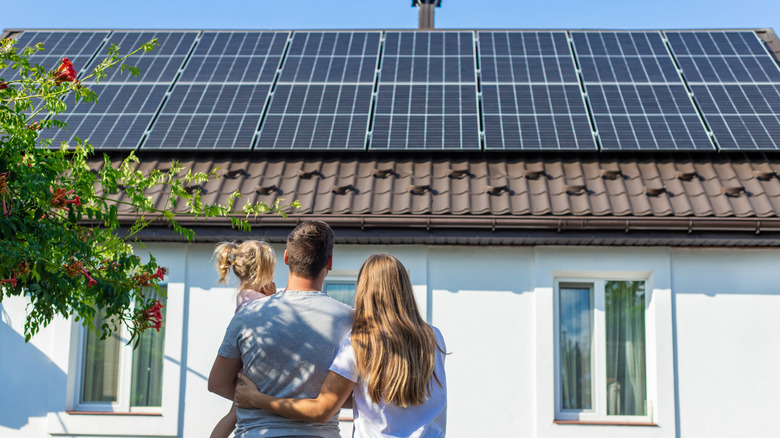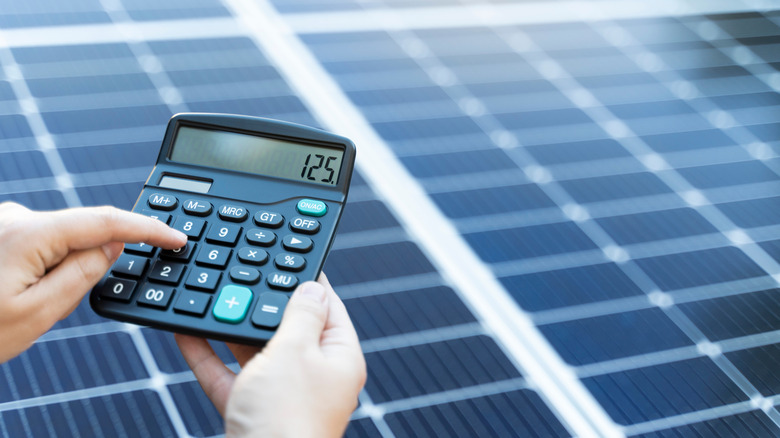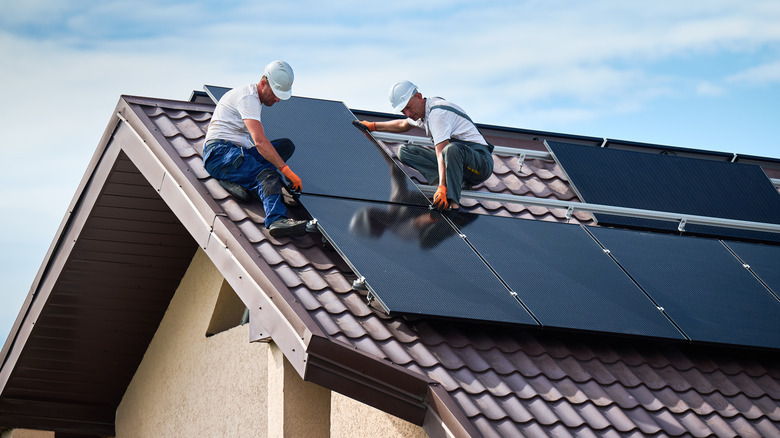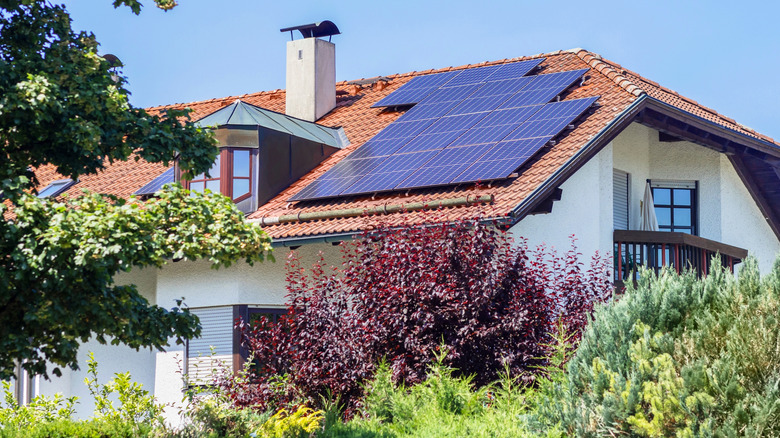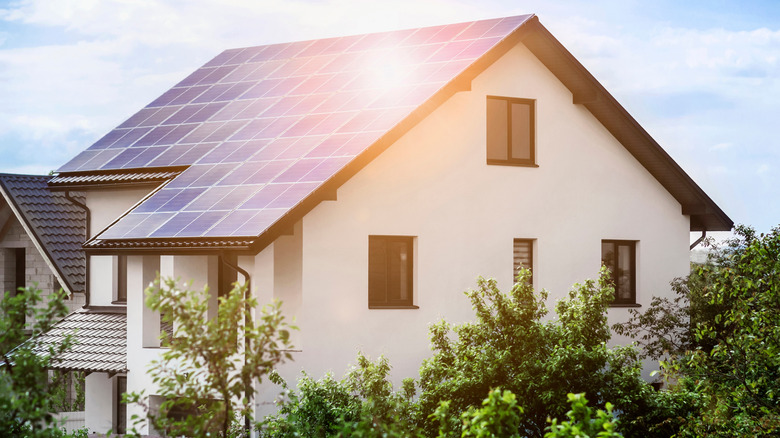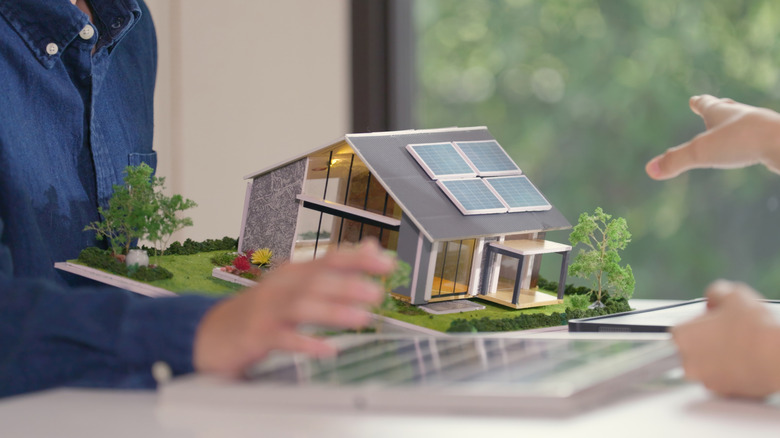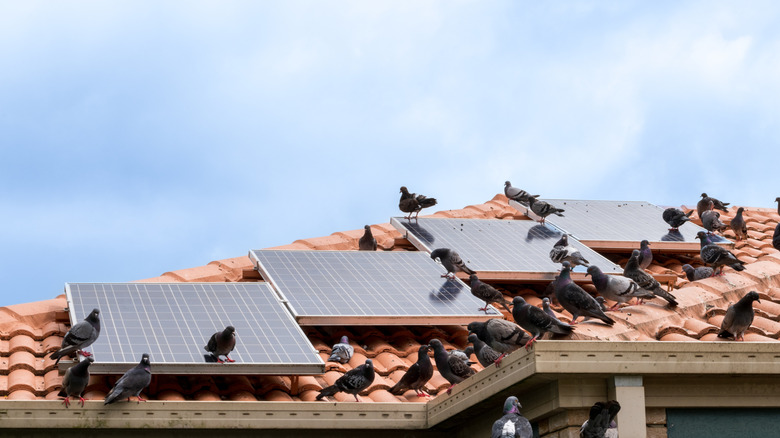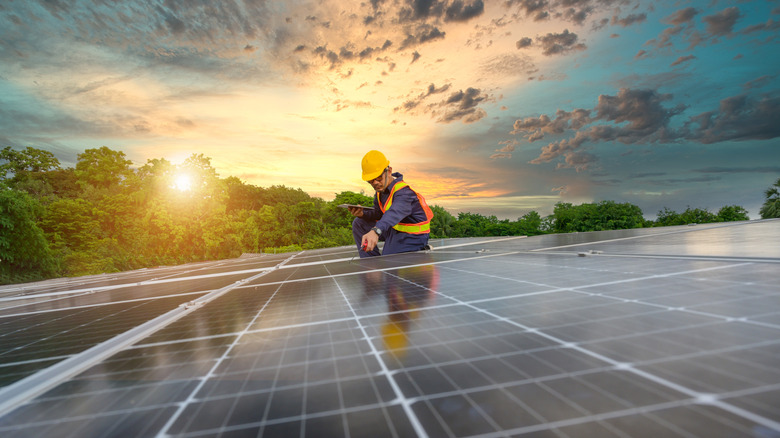Thinking About Installing Solar Panels For Your Home? Here's What You Should Know First
If you've ever looked at your energy bills and thought, "Why am I paying all this money when there's literally free energy beaming down from the sky?", well, you've got a point. While solar panels generated only 6.8% of all U.S. electricity in 2024, this share is growing fast as homeowners seek cleaner, more independent, and more affordable ways to power their homes. Most electricity in the U.S. still comes from fossil fuels like natural gas, coal, and oil. These fuels are burned to produce heat, which turns water into steam that spins turbines to generate power, a process that emits carbon dioxide and other greenhouse gases, contributing to climate change. By contrast, solar panels create electricity directly from sunlight, with no fuel and no emissions, making them a cleaner, renewable alternative.
Strapping highly technical bits of kit to your roof and generating your own power isn't straightforward. It also isn't for everyone. The shape, age, and orientation of your roof, the amount of electricity you use, where you live, and even your local regulations all influence whether installing solar panels is a good idea for you. Most homeowners don't go fully off-grid. In fact, many still rely on their local utility to fill in the gaps when the sun isn't shining. Yet that doesn't mean solar isn't worth it. With the right setup, panels can shrink your energy bills, increase your home's value, and dramatically cut your carbon footprint — even if you still buy some power from the grid.
Solar panels will save you money — but it might take a while
This is the big question. If you're thinking about having solar panels installed, you want to know if you're going to save money. While sunshine is free, the equipment that turns it into usable electricity costs money, and the upfront investment can be substantial. As of 2025, the average cost of a residential solar system in the U.S. is around $3.33 per watt installed, or roughly $12,000 to $24,000 for a typical 5- to 10-kilowatt system. That figure includes the panels, inverters, mounting hardware, permitting, and professional installation. Optional extras, like battery storage, can add many thousands more.
You'll need to be patient to see any savings. It takes between eight and 15 years for most people with solar panels to break even. Homes with higher electricity bills usually see the biggest savings, because every bit of power you generate with solar replaces energy you'd otherwise have to buy. If your energy use is fairly low, or if you live somewhere with cheaper utility rates, your monthly savings will be smaller — which means it takes longer for the system to pay for itself. Tools like EcoWatch's Solar Calculator can help you estimate installation costs, incentives, and expected lifetime savings based on your ZIP code and current energy bills.
There may be red tape, but there are also government incentives
Solar panels can be a smart investment, but before you can start soaking up the sun, there's often a bit of paperwork and permitting to get through. Some cities and counties require building permits or inspections to ensure your system meets local codes and safety standards. For instance, homeowners in New York City and parts of California's San Bernardino County need official permits before installation. Your installer can usually help you handle the paperwork, but it's worth checking with your local building department early in the process to avoid delays or unexpected fees. If you're part of a homeowners' association (HOA), you will likely need to submit a request for approval. In most cases, it shouldn't be a problem, as many states have solar access laws that stop HOAs from banning or unfairly restricting solar panel installation.
Plus, form-filling isn't all bad news. Some government schemes save you money. There are substantial incentives designed to make solar more affordable. At the federal level, the Residential Clean Energy Credit means you can claim as much as 30% of your solar panel installation costs as a credit on your income taxes. Many states and municipalities layer on additional perks, such as property tax exemptions, sales tax exemptions, or cash rebates, depending on local policy. Depending on where you live, these exemptions and rebates can save you a lot of money.
Solar panels can increase the value of your home
While opinions may differ on whether solar panels enhance the look of your home, there's broad agreement that they add real financial value. According to a report by Solar Reviews, on average, homes that have solar panels sell for almost 7% more than those without. That added value depends on a few key factors. Homes with solar systems that you've purchased outright are attractive to buyers. But if you've entered into a lease agreement for your panels, that complicates things because you're asking the new owner to take over the lease. The local housing market also plays a role. The report found that house sales in New York, Kentucky, and Michigan saw a greater premium on homes with solar panels, whereas in other states, like Alabama, those benefits were small (or non-existent).
While there's usually a long wait for a return on investment with solar panels, increased house sale prices can actually provide an instant win. For example, the average house price in Kentucky is around $223,000. Solar panels add around 9.8% to the sale price. That's an added value of $21,854, far in excess of the average cost of installing solar panels in Kentucky, which is likely to be $13,150. You probably aren't planning to install solar panels if you're going to move house immediately. However, it's good to know that if you do, you could recoup your investment in full and even make a profit.
Not all roofs are suitable
The future may have transparent solar panels in store, but for now, you need to establish whether your roof can actually support a solar system. It all depends on factors like orientation, shading, size, and age. Solar panels perform best when they face south in the Northern Hemisphere, where they capture the most sunlight throughout the day. East- and west-facing roofs can still be effective, but they'll produce less electricity overall, resulting in a longer payback period. Roofs that face north usually aren't ideal for solar, but there are workarounds — like special mounts that tilt the panels – but obviously, these will increase your costs.
Shading is another big factor. Trees, chimneys, or nearby buildings that block sunlight for long parts of the day can significantly reduce your system's output. Installers use tools like solar pathfinders to measure potential shading and determine whether the payoff will still make sense. Your roof's condition and strength are also important. Solar panels last 25 to 30 years on average, so if your roof is nearing the end of its life, you may need to replace it before installing panels. Structurally, it must be strong enough to support the extra weight of the array, which is typically around 3 to 4 pounds per square foot.
You'll also need enough usable roof space. For example, a household using 1,000 kWh per month — a typical amount for an average family — would likely need between 330 and 600 square feet of roof space to accommodate enough solar panels. If your roof isn't viable, you could consider ground-mounted panels in your backyard. These do have some drawbacks, though, as they are more expensive and require a significant amount of space.
It all depends on what state you live in
Solar power can be a good investment no matter where you live, but the scale of its reward depends heavily on your state's incentives, electricity rates, and policies. While federal credits help everywhere, some states offer extras that turn solar from possible into an extremely attractive option. New York stands out among states with strong support for solar energy. On top of the federal Residential Clean Energy Credit, New York offers a state-level solar energy credit, often around 25%, which in many cases provides up to $5,000. Massachusetts also ranks high for solar friendliness. Its SMART (Solar Massachusetts Renewable Target) program, property-tax exemptions, sales tax waivers, and state income tax credits all contribute. In Maryland, residents can benefit from a $1,000 rebate under the Residential Clean Energy Rebate Program. Maryland also waives sales tax on solar equipment and installation fees, and excludes solar value increases from property tax assessments, all of which reduce upfront and ongoing costs.
California has big plans for solar energy as a long-term solution and offers property tax exemptions and other incentives to homeowners installing solar panels. Meanwhile, South Carolina provides a 25% tax credit that can save homeowners up to $3,500. On the other hand, states such as Idaho, Nevada, Wyoming, and Pennsylvania lack comprehensive state-level solar tax credits, leaving homeowners largely dependent on federal incentives and local utility rebates.
Weather matters, too. Panels thrive on sunlight, not heat, so cool, sunny conditions often produce electricity more efficiently than scorching temperatures. Occasional rainfall helps by keeping panels clean. That means high-sun states like California and Arizona consistently perform well, while cooler but sunny states, such as Colorado or Utah, can also be strong contenders.
You can store your own power or sell it back
One of the biggest decisions when installing solar panels is whether to purchase a battery. A solar battery stores the unused electricity your panels generate during the day, so you can use it as a backup power source in the evening or during cloudy weather. However, it costs, on average, $11,000 to buy and install solar batteries. Although, of course, the amount you'll pay will depend on multiple factors, such as the brand and storage battery size. That expense can add years to your payback period, so for many households, batteries are a nice-to-have rather than a must. Without one, your system still works. Excess power simply flows back to the grid.
This is where buyback programs, often referred to as net metering, come in. When your panels produce more electricity than your home uses, the extra flows through your smart meter into the public grid. These modern meters are bidirectional, tracking both the power you draw in from the grid and the surplus you send out. Utilities use those readings to calculate your credits or payments for the energy you supply. Programs vary widely across the country. More than half of U.S. states – 38 states plus Washington, D.C. — have official regulatory net metering rules, while others rely on voluntary programs offered by local utilities or city governments. A few states, including New Jersey, Illinois, and Washington, D.C., offer full retail-rate net metering, meaning you're credited for excess power at the same rate you pay for electricity. Many others, such as Rhode Island, Massachusetts, and Connecticut, credit surplus energy at a reduced rate, often closer to the wholesale value. In some places, such as South Dakota and Tennessee, there are currently no statewide net metering or equivalent programs.
Solar panels won't stay at peak power forever
Once installed, solar panels quietly do their job day after day, often for 25 to 30 years or more. But like any technology, they slowly lose efficiency over time. This process, known as degradation, means panels generate slightly less electricity each year than when they were new. Most modern panels degrade at a rate of about 0.5% per year, although it depends on the brand, build quality, local weather, and maintenance. So while panels don't suddenly stop working, they do gradually become less productive.
After 25 years, most panels will still have about 88% to 93% of their original output, with many brands guaranteeing a specific efficiency percentage at that time. You can prolong the life of solar panels with regular maintenance. Keep panels clean and unobstructed by removing dirt, leaves, or bird droppings, which can block sunlight and cut output. In many areas, rainfall does most of the cleaning, but a gentle wash once or twice a year can help. Many homeowners hire a professional for a quick inspection every few years to check wiring, mounting, and inverters. Meanwhile, research is ongoing to invent more efficient solar panels. Scientists in Germany have produced ultra-thin solar panels using crystals that may be up to a thousand times more efficient.
Solar panels make a big difference to the environment
Arguably, the most important thing you need to know is whether or not installing solar panels will help save the planet. And the answer is, yes, it will. Electricity generation is one of the largest sources of greenhouse gas emissions in the U.S., and most of it still comes from burning fossil fuels, such as coal and natural gas. These fuels release carbon dioxide and other pollutants that contribute to global warming and degrade air quality. Solar energy, by contrast, produces electricity without burning anything and without direct emissions, making it one of the most effective tools we have to reduce our carbon footprint.
That doesn't mean solar is completely impact-free. Manufacturing panels requires energy, raw materials, and water, and the process still relies partly on fossil fuels. Mining for components such as silicon, silver, and copper has its own environmental impact. And while most panels last for decades, recycling systems for when they eventually reach the end of their life are still being developed. The good news is that researchers are investigating innovative solutions to the problem, like creating living solar panels made out of bacteria, although we're a long way off from being able to install that breakthrough on our roofs.
While there are still costs to manufacturing panels, solar's lifetime benefits far outweigh its impacts. Many panels pay back the energy used to make them and go on to generate decades of clean power. We humans may be largely responsible for climate change, but you can still make a small but meaningful contribution to a more sustainable world.
